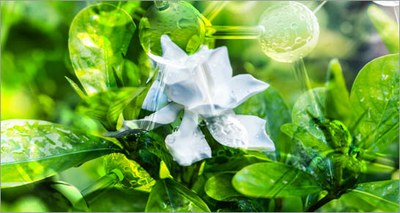Health: International team sequences the gardenia's genome
2/7/2020
New perspectives for sustainable production of molecules useful to man
 An international research team, comprising ENEA, Academy of Sciences - Institute of medicinal plants (China) and University of Buffalo (United States) has decoded the DNA of Gardenia jasminoides, a plant used in traditional Chinese medicine that produces crocins, pharmacologically important pigments also found in saffron stigmas.
An international research team, comprising ENEA, Academy of Sciences - Institute of medicinal plants (China) and University of Buffalo (United States) has decoded the DNA of Gardenia jasminoides, a plant used in traditional Chinese medicine that produces crocins, pharmacologically important pigments also found in saffron stigmas.
The study was published in "BMC Biology", the flagship biology journal of the open access group Biomed Central (Springer publisher). The decoding of the genome of this ornamental plant and, in particular, of the genes involved in crocin production, has made it possible to shine a light on sustainable production of molecules useful to man. Crocins, for instance, have a protective action on the retina and, more generally, have an anti-inflammatory and antioxidant role in the central nervous system. An interesting fact: since the Qin and Han dynasties, which founded the first Chinese empire over 2 thousand years ago, crocins have been used to dye the the emperor’s clothes.
“Plants are the best organic chemists on the planet. They synthesize up to 1 million molecules, many of which have a medicinal, psychotropic or toxic action", Giovanni Giuliano, coordinator of the ENEA team and co-corresponding author of the study, pointed out.
"Approximately 30% of the active ingredients used as medicines or food supplements - he continued - are of plant origin or inspired by molecules produced by plants".
The team of scientists focused, in particular, on the evolution of two molecules - crocins in Gardenia jasminoides and caffeine in Coffea canephora (robusta coffee) – which both belong to the Rubiaceae family. "By comparing the gardenia genome with that of coffee, which we had sequenced in 2014, we discovered that their common ancestor, who lived approximately 20 million years ago, had a gene coding for an enzyme called CCD4 on chromosome 9", Giuliano explained.
This gene exixts in a single copy in coffee, while in Gardenia it gave rise to a 'cluster' comprising 4 'offspring' genes, one of which encodes the key enzyme for crocin biosynthesis.
All the other genes and enzymes for this synthesis already existed in the common ancestor. A similar process - which took place ON/FROM a different gene, called NMT and located on chromosome 8 of the common ancestor - gave rise to the synthesis of caffeine, a psychoactive alkaloid widely consumed by man in the form of infusions.
Both crocins and caffeine are synthesized from plants evolutionarily very distant from each other: crocins, besides Gardenia, are produced also from saffron and Buddleja, whereas caffeine is produced from a wide variety of plants used by man for making infusions, like coffee, tea, guarana, cocoa and yerba mate.
Therefore, both crocins and caffeine have been 'reinvented' several times during the evolution of different plants, a phenomenon called by biologists the 'convergent evolution'. This phenomenon constitutes an evolutionary paradox, since the synthesis of these molecules requires the simultaneous action of many enzymes and it is difficult to imagine how these enzymes can all evolve together in plants evolutionarily distant from each other.
"Our findings suggest that the emergence of new molecules, such as crocin and caffeine, in evolutionarily distant plants occurs through the appearance of one or a few genes and enzymes that catalyze the key passages, while all the others are 'recruited' by pre-existing metabolic pathways. It is a sophisticated demonstration, on a biochemical level, of how naturerecycles and adapts pre-existing mechanisms, instead of creating them ex-novo.
Understanding these mechanisms would make it possible to synthesize new molecules in plants by transferring one or a few genes coding for key enzymes. A very interesting perspective for sustainable production of molecules useful to man", Giuliano concluded.
For more information please contact:
Giovanni Giuliano, ENEA – Biotechnologies and Agroindustry Division, giovanni.giuliano@enea.it
The unabridged study: Tandem gene duplications drive divergent evolution of caffeine and crocin biosynthetic pathways in plants
